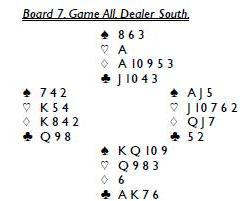The World Wide Bridge Contest is a long-standing tournament in the World Bridge Federation’s calendar, 2013 is its 27th year, and I do hope you all enjoyed this event and found the hands interesting and challenging – my thanks go to Eric Kokish for his excellent and most entertaining commentary. Gianarrigo Rona, President, World Bridge Federation.
The cards are lying particularly well for N/S, who can make 5![]() or a far less likely 4
or a far less likely 4![]() with an accurate line of play. This figures to be a partscore
with an accurate line of play. This figures to be a partscore
deal, however, so anyone securing the game bonus will score mightily.
North will more often respond 1![]() than 2
than 2![]() or 3
or 3![]() to South’s 1
to South’s 1![]() . East, with a balanced hand, modest point count, and topless five-card suit, doesn’t really have the material for a vulnerable overcall, but that won’t dissuade everyone. 1
. East, with a balanced hand, modest point count, and topless five-card suit, doesn’t really have the material for a vulnerable overcall, but that won’t dissuade everyone. 1![]() will be raised to two, where E/W are in serious jeopardy (-200 or -500) if N/S can arrange to sell out, doubled or not, but fortunately for these traveling pairs, N/S will usually opt to bid on in clubs. Where N/S are given a free run, they should be able to stop in 3
will be raised to two, where E/W are in serious jeopardy (-200 or -500) if N/S can arrange to sell out, doubled or not, but fortunately for these traveling pairs, N/S will usually opt to bid on in clubs. Where N/S are given a free run, they should be able to stop in 3![]() ; sample auctions include: (a) 1
; sample auctions include: (a) 1![]() -1
-1![]() ; 1
; 1![]() -3
-3![]() ; pass (b) 1
; pass (b) 1![]() -3
-3![]() ; pass (c) 1
; pass (c) 1![]() -2
-2![]() (inverted); 3
(inverted); 3![]() -Pass. Although South has a sound opening bid, it is still in the minimum range, and with only four clubs and potentially the wrong singleton, both 5
-Pass. Although South has a sound opening bid, it is still in the minimum range, and with only four clubs and potentially the wrong singleton, both 5![]() and 3NT figure to require both a favorable layout and some good play. Although clubs offers only 20 points a trick, there’s no shame in trying to go plus in a sound trump suit when higher scoring strains are speculative, even at Pairs scoring. Those plus scores will score well this time.
and 3NT figure to require both a favorable layout and some good play. Although clubs offers only 20 points a trick, there’s no shame in trying to go plus in a sound trump suit when higher scoring strains are speculative, even at Pairs scoring. Those plus scores will score well this time.
The defense against a N/S notrump contract should be able to prevent declarer from developing a ninth trick – presumably a second winner in a red suit – but we can imagine scenarios in which declarer’s spot cards in hearts or diamonds come into play before declarer builds two winners in the other red suit.
To come to 11 tricks in clubs, declarer will need to ruff two low hearts in dummy to make a winner of the ![]() Q, leading spades towards the honors en route. An interesting variation might materialize where East has not bid hearts and
Q, leading spades towards the honors en route. An interesting variation might materialize where East has not bid hearts and
follows with the ten or jack on declarer’s first heart ruff, giving declarer the option of leading the ![]() Q to pin East’s remaining minor honor the next time he plays the suit, a line that would work when East started with J10x of hearts. Declarer has other concerns to deal with (avoiding an extra loser in the trump suit, timing the play to be able to cash his spade winners), but even if he does the wrong (odds-against) thing in hearts, the cards are friendly enough for him to negotiate a third heart ruff without losing an extra trick.
Q to pin East’s remaining minor honor the next time he plays the suit, a line that would work when East started with J10x of hearts. Declarer has other concerns to deal with (avoiding an extra loser in the trump suit, timing the play to be able to cash his spade winners), but even if he does the wrong (odds-against) thing in hearts, the cards are friendly enough for him to negotiate a third heart ruff without losing an extra trick.
Unless South opens 1![]() or North imaginatively places the contract in 2
or North imaginatively places the contract in 2![]() when South’s opening shows a three-suiter short in diamonds, it’s difficult to see how N/S will find a logical route to a spade contract. Even two rounds of trumps
when South’s opening shows a three-suiter short in diamonds, it’s difficult to see how N/S will find a logical route to a spade contract. Even two rounds of trumps
won’t prevent declarer from taking 10 tricks with accurate play: he can take one heart ruff, draw the last trump, and clear clubs (unblocking from dummy), win the diamond return, cross to a club and lead the ![]() 9 to catch the king. This all sounds fancier than it really is.
9 to catch the king. This all sounds fancier than it really is.
